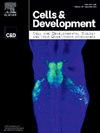Extracellular matrix in cardiac morphogenesis, fibrosis, and regeneration
IF 2
4区 生物学
Q4 Biochemistry, Genetics and Molecular Biology
引用次数: 0
Abstract
The extracellular matrix (ECM) plays a crucial role in providing structural integrity and regulating cell communication essential for organ development, homeostasis, and regeneration, including hearts. Evidence indicates that disruptions in the spatiotemporal expression or alterations in ECM components lead to cardiac malformations, including a wide range of congenital heart diseases (CHDs). Furthermore, research on injured hearts across various vertebrate species, some of which show effective regeneration while others experience irreversible fibrosis, underscores the significance of ECM molecules in cardiac regeneration. This review presents an overview of heart development and the dynamics of ECM during cardiac morphogenesis, beginning with the formation of the contractile heart tube and advancing to the development of distinct chambers separated by valves to facilitate unidirectional blood flow. Furthermore, we discuss research emphasizing the multifaceted roles of secreted molecules in mediating fibrosis and regeneration following myocardial injury.
细胞外基质在心脏形态发生、纤维化和再生中的作用。
细胞外基质(ECM)在提供器官发育、体内平衡和再生所必需的结构完整性和调节细胞通讯方面起着至关重要的作用,包括心脏。有证据表明,时空表达的中断或ECM成分的改变可导致心脏畸形,包括多种先天性心脏病(CHDs)。此外,对各种脊椎动物损伤心脏的研究表明,其中一些动物表现出有效的再生,而另一些动物则经历了不可逆的纤维化,这强调了ECM分子在心脏再生中的重要性。这篇综述概述了心脏发育和心脏形态发生过程中的ECM动力学,从可收缩的心管的形成开始,到由瓣膜分隔的不同腔室的发展,以促进单向血液流动。此外,我们讨论了强调分泌分子在介导心肌损伤后纤维化和再生中的多方面作用的研究。
本文章由计算机程序翻译,如有差异,请以英文原文为准。
求助全文
约1分钟内获得全文
求助全文
来源期刊

Cells and Development
Biochemistry, Genetics and Molecular Biology-Developmental Biology
CiteScore
2.90
自引率
0.00%
发文量
33
审稿时长
41 days
 求助内容:
求助内容: 应助结果提醒方式:
应助结果提醒方式:


